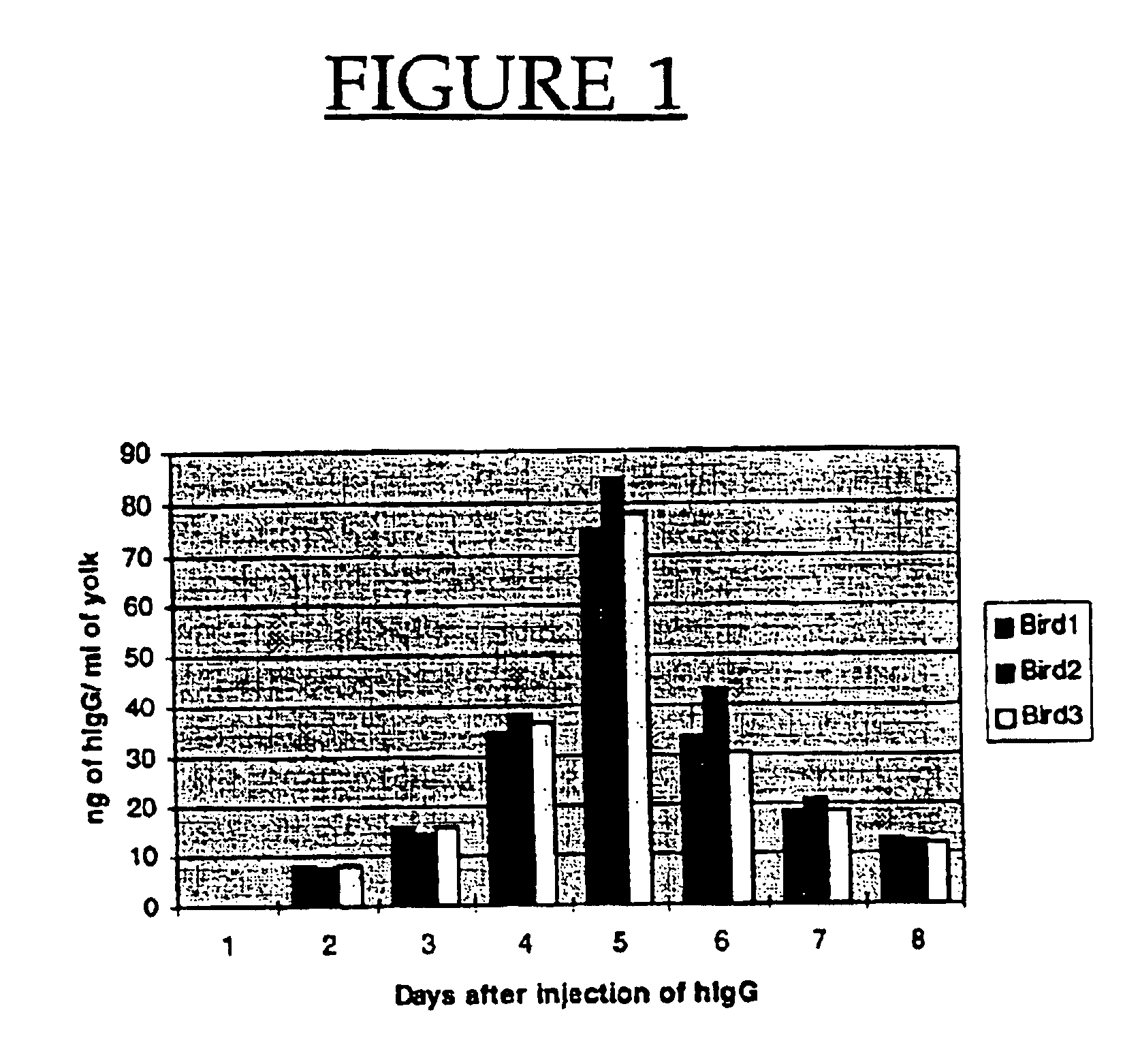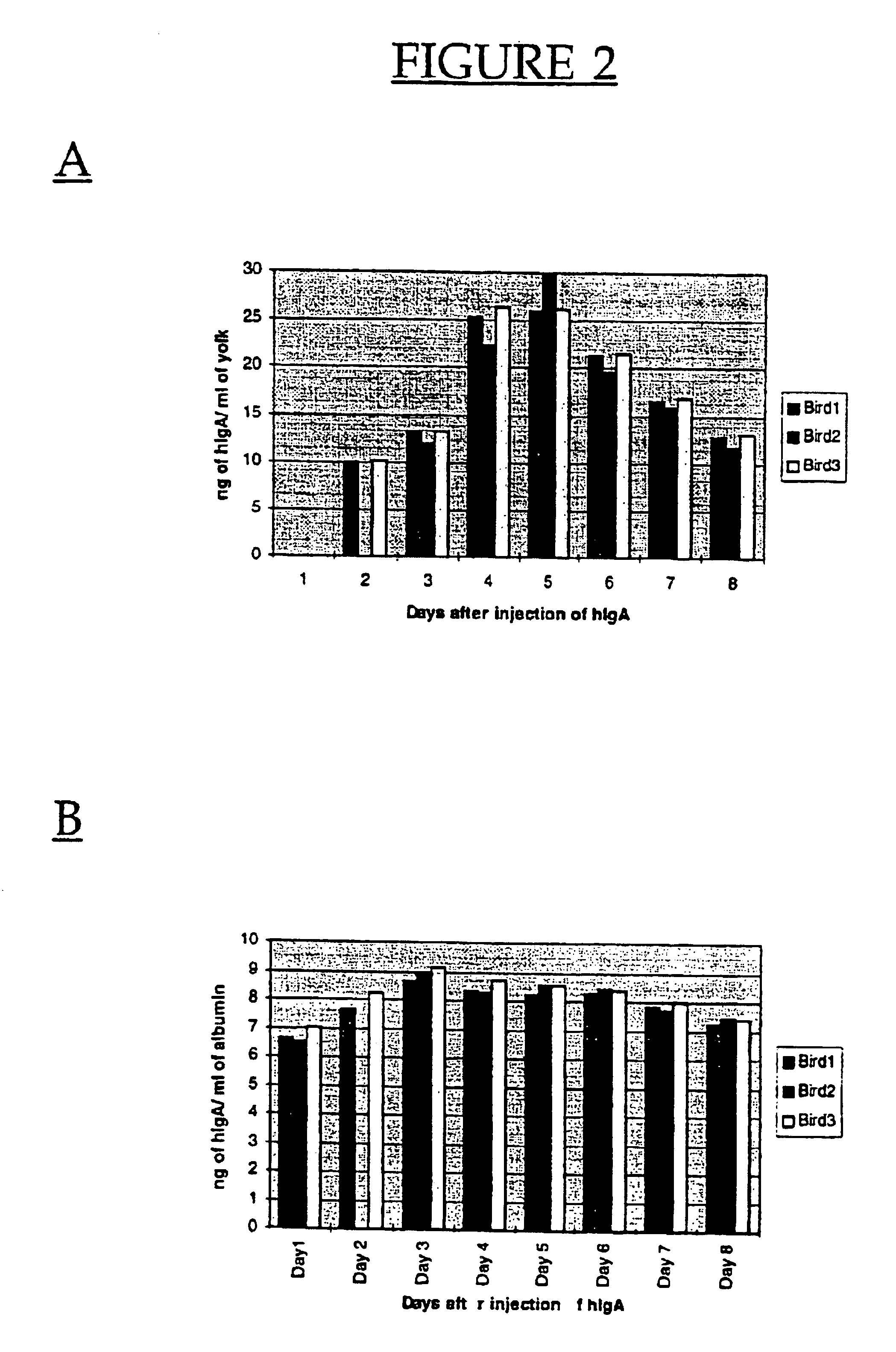Production of proteins in eggs
a technology of recombinant proteins and eggs, which is applied in the field of recombinant protein production in eggs, can solve the problems of inability to prepare large quantities of human antibodies from a human source, prohibitive existing methods for producing recombinant proteins, and limited human product supply, so as to achieve the effect of prevention and treatmen
- Summary
- Abstract
- Description
- Claims
- Application Information
AI Technical Summary
Benefits of technology
Problems solved by technology
Method used
Image
Examples
second embodiment
In a second embodiment, the recombinant protein may be delivered to the egg by introducing a host cell that has been transformed with an expression system of the present invention into the egg-laying animal. The transformed cell line will secrete the recombinant protein which will be transported to the egg. Preferably the host cell is an avian cell line, specifically a pluripotent or multipotent embryonic cell line, a cell line committed to the germ line or any cell line that can contribute to somatic tissues and the germ line.
Accordingly, the present invention provides a method for preparing a recombinant protein in an egg comprising:a) introducing a transformed avian cell line that secretes a recombinant protein into an egg-laying animal wherein the avian cell line has been transformed with an expression system comprising (i) a first DNA sequence encoding the recombinant protein and (ii) a second DNA sequence which facilitates the delivery of the protein to an egg of an animal;b) ...
example 1
Uptake of Human Antibodies in the Chicken Egg
To determine if human IgG (hIgG) is capable of being transported into the developing chicken follicle, three Hyline SC™ hens were each injected with 10 μg of purified hIgG and its presence in egg yolk and egg white assessed by ELISA. Human IgG was first detected in egg yolk on Day 2, with peak levels of up to 89 ng / ml detected on Day 5 (FIG. 1). No hIgG was detected in the thin albumen extracts indicating that the concentration was less than 3.12 ng / ml (the detection limit of the ELISA assay).
Ten μg of human IgA (hIgA) was also intravenously injected into three Hyline SC™ hens to determine if hIgA was also capable of being deposited into the egg. Human IgA was first detected in the egg yolk on Day 2 with peak levels of up to 33 ng / ml detected on Day 5 (FIG. 2A) which was significantly less than the peak deposition recorded for hIgG (Repeated Measures Analysis, P<0.01). Although hIgG was not detected in egg white extracts, hIgA was. H...
example 2
Uptake of Recombinant IgG in Chicken Eggs
Material and Methods
Culture and Transfection of Cell Lines
A chicken B lymphoblastoid cell line, DT40, derived from Hyline SC™ chickens (Hyline International, Dallas Center, Iowa) was obtained from Dr. Craig Thompson and used to establish transfected cell lines producing human / mouse chimeric antibodies. Cells were maintained in culture at 1-10×106 cells / ml in IMDM™ (Gibco BRL) containing 8%(v / v) Bovine Calf Serum (BCS and 2% (v / v) Chicken Serum (CS). Cells (1×107) were transfected with 20 μg each of linearized heavy chain (chimeric anti-dansyl gamma 1) and light chain (chimeric anti-dansyl light chain with human kappa) by means of electroporation using a Bio-Rad electroporator under optimized electroporation conditions (200V, 960 uF and 1000 msec pulse). Cells were maintained for two days in the above culture media in 96-well micro-titer dishes (2.5×104 cells / well) after which selection medium containing 3 μg / ml mycophenolic acid, 7.5 μg / ml hy...
PUM
| Property | Measurement | Unit |
|---|---|---|
| Mass | aaaaa | aaaaa |
Abstract
Description
Claims
Application Information
 Login to View More
Login to View More - R&D
- Intellectual Property
- Life Sciences
- Materials
- Tech Scout
- Unparalleled Data Quality
- Higher Quality Content
- 60% Fewer Hallucinations
Browse by: Latest US Patents, China's latest patents, Technical Efficacy Thesaurus, Application Domain, Technology Topic, Popular Technical Reports.
© 2025 PatSnap. All rights reserved.Legal|Privacy policy|Modern Slavery Act Transparency Statement|Sitemap|About US| Contact US: help@patsnap.com



